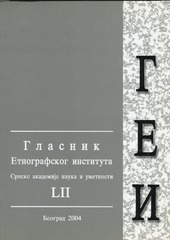Prikaz osnovnih podataka o dokumentu
Василица и самоодређење Рoмa
Vasilica and self-determination of Roma
| dc.creator | Златановић, Сања | |
| dc.date.accessioned | 2020-06-01T18:59:50Z | |
| dc.date.available | 2020-06-01T18:59:50Z | |
| dc.date.issued | 2004 | |
| dc.identifier.issn | 0350-0861 (print) | |
| dc.identifier.issn | 2334-8259 (online) | |
| dc.identifier.uri | https://dais.sanu.ac.rs/123456789/8785 | |
| dc.description.abstract | Василица и Ђурђевдан су два најзначајнија празника у годишњем циклусу врањских Рома. Док прослављање Ђурђевдана Роми углавном доводе у везу с културом већинске групе Срба, чије елементе усвајају дајући им специфичну интерпретацију, Василицу доживљавају као свој праэник. У раду се даје згуснут опис обележавања Василице у периоду од 2001. до 2004. године у насељима Горња Чаpшија и Сарајина у Врању, а затим различита објашњења информатора о пореклу празника, да би се сагледала његова улога у самоидентификацији. Рад има за циљ да пружи емпиријско упознавање ситуације. | sr |
| dc.description.abstract | Vasilica and Đurđevdan are the two most important holidays in the yearly cycle among the Roma of Vranje (Southern Serbia). While they connect the celebration of Đurđevdan (6th of May) mainly with the culture of the Serbian majority group (whose elements they assimilate, giving them a specific interpretation), Vasilica is considered to be a true Roma holiday. During the discussions, all the informants emphasized that Vasilica is the most important Roma holiday, more significant than Đurđevdan. Vasilica consists of two segments. The date of the first one, which can be called the preparation, greeting and celebration of Vasilica, is a fixed one (from 12th to 17th of January, 14th of January being the actual holiday), while the date of the second segment -farewell to the goose - is set individually by every household. This paper offers a thick description of both segments of Vasilica, depicting the way it has been celebrated between 2001 and 2004 in the settlements Gornja Čaršija and Sarajina of Vranje. It also includes selected statements of the informants, as well as the text of the local TV broadcast dedicated to the celebration of Vasilica. The different explanations of the origin of this most important Roma holiday, in light of the current identity problems in Serbia - both of the majority and of the minority group - point to the complexity and polysemy of the answer to the question: Who am I? The aim of this paper is to offer an empirical insight into the situation. | en |
| dc.language.iso | sr | sr |
| dc.publisher | Београд : Етнографски институт САНУ / Belgrade : Institute of Ethnography SASA | sr |
| dc.relation | Савремена сеоска и градска култура – путеви и трансформација, бр. 1868 / Contemporary Rural and Urban Culture - Ways of Transformation, no. 1868 | sr |
| dc.rights | openAccess | sr |
| dc.rights.uri | https://creativecommons.org/licenses/by-nc-nd/4.0/ | |
| dc.source | Гласник Етнографског института САНУ / Bulletin of the Institute of Ethnography SASA | sr |
| dc.subject | Роми | sr |
| dc.subject | гуска | sr |
| dc.subject | празник | sr |
| dc.subject | годишњи циклус | sr |
| dc.subject | идентитет | sr |
| dc.subject | самоидентификација | sr |
| dc.subject | Roma | sr |
| dc.subject | Vranje | sr |
| dc.subject | Vasilica | sr |
| dc.subject | holiday | sr |
| dc.subject | yearly cycle | sr |
| dc.subject | goose | sr |
| dc.subject | goose | sr |
| dc.subject | self-identification | sr |
| dc.title | Василица и самоодређење Рoмa | sr |
| dc.title | Vasilica and self-determination of Roma | en |
| dc.type | article | sr |
| dc.rights.license | BY-NC-ND | sr |
| dcterms.abstract | Zlatanović, Sanja; Vasilica i samoodređenje Roma; Василица анд селф-детерминатион оф Рома; Василица анд селф-детерминатион оф Рома; | |
| dc.rights.holder | Етнографски институт САНУ | sr |
| dc.citation.spage | 155 | |
| dc.citation.epage | 164 | |
| dc.citation.volume | 52 | |
| dc.identifier.doi | 10.2298/GEI0452155Z | |
| dc.type.version | publishedVersion | sr |
| dc.identifier.fulltext | https://dais.sanu.ac.rs/bitstream/id/33492/bitstream_33492.pdf | |
| dc.identifier.rcub | https://hdl.handle.net/21.15107/rcub_dais_8785 |

